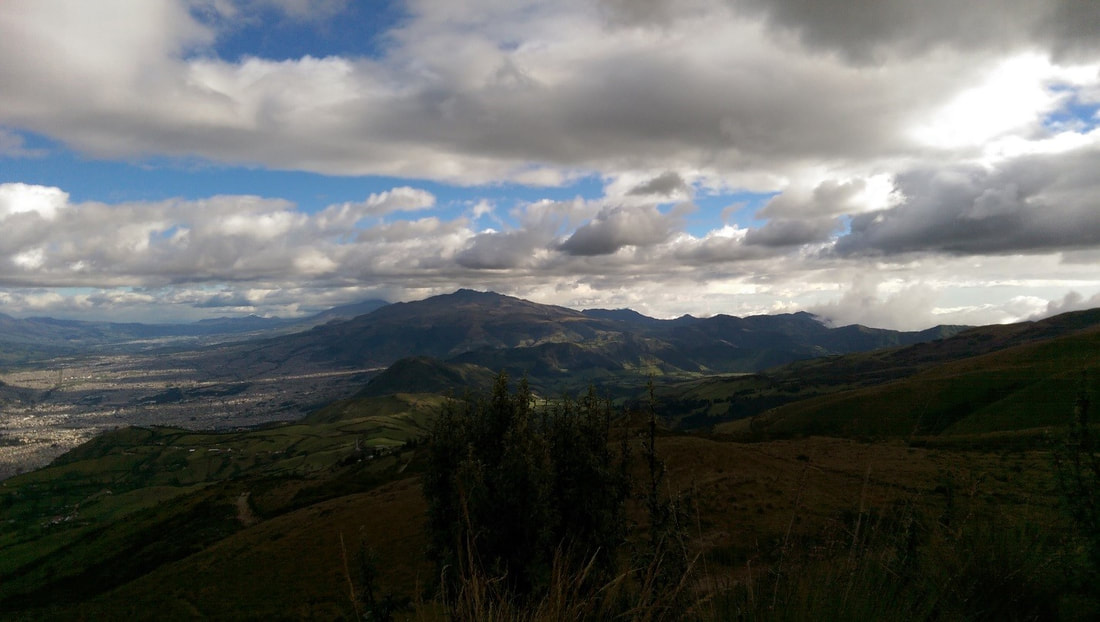|
Summer is winding down (even if the weather doesn't feel like it), you're checking everything off your school supply lists, and you (or the kids) are headed off to a new term of classes! Before we know it, we'll be reaching for winter coats and preparing for the holiday season. If you follow AIHREA's social media pages you might have noticed that during the month of August we've been focusing on our indigenous neighbors to the south, in Central and Southern America (if you aren't following us on social media, click the icons under our logo at the top of the page to make sure you never miss an update!). We'll be continuing that trend with our newsletter this month with a special piece from summer intern Fatima Rahman about her time in Ecuador! Otavalo Indígenas of Ecuador  On a crisp Saturday morning in May 2016, AIHREA intern and University of Kansas Medical Center Masters of Public Health graduate Fatima Rahman was immediately fascinated by the flourishing market and music of Otavalo, Ecuador. While spending her mornings filling vials for blood tests and learning about all the different types of stomach bugs affecting socioeconomically disadvantaged Ecuadorians during her time volunteering with a non-profit medical clinic in Quito, Ecuador, she spent her afternoons and weekends hunting down gems in Ecuadorian culture like the market in Otavalo. Located in a lush valley of the Andean mountains in northern Ecuador, Otavalo is home to more than 45,000 Otavalo indígenas – one of the most thriving indigenous groups in Latin America. Otavalo indígenas, famous for weaving, agriculture and music, are a talented group of Andean natives with a knack for business that dates to as far as pre-Incan times in the 15th century. Researchers interested in Otavalo indígenas agree that the inherent resilience in this native community, despite brutal colonialism and westernization, has much to do with them maintaining a strong cultural presence through music and dress code while participating in the modern business market of Ecuador and globally (Meisch, 2013). The skill of Otavalo indígenas in textile, weaving, and manufacturing survived through Inca society and colonialism, into the modern 21st century. In pre-Inca society, Otavalos (then a part of the pre-Colombian Cara culture) catered their businesses to traveling merchants. In the 16th century, pre-Inca Otavalos were forcibly assimilated into the Inca civilization. Following assimilation, and later colonialism, they were victims of forced labor in textile sweatshops for mass production and exploited for their talent. Today, however, Otavalo indígenas have more space to create and market their textiles in the crowded Otavalo markets every Saturday morning, and in smaller markets in and around Quito, the capital of Ecuador. The success of Otavalo in Ecuadorian society, despite historical discrimination, oppression and poverty, is partially attributed to efforts by the Ecuadorian government to ban discrimination and protect the rights of indigenous in the country. For example, after pressure from the Indigenous Nationality Confederation of Ecuador (CONAIE), the government of Ecuador recognized indigenous and Afro-Ecuadorian nationalities in their constitution in 1998 – paving the way for acceptance and increased diversity in Ecuadorian communities (Becker, 2011). While shopping the Otavalo market, she experienced the same euphoria she felt when shopping in her own ancestral home of Bangladesh. Walking into the shops, she was pleasantly startled by the brightly colored blankets, hammocks, and handbags among other goods. Personalized journals carved out of musky leather and alpaca-wool sweaters were the hit of the market. She bargained her way through the market with her limited Spanish before hitting the local bakeries for fresh Yuca bread. At one point, she was both exhausted and impressed from bargaining with an Otavalo young woman for a cotton shawl. Otavalo indígenas are critical parts of the Ecuadorian market economy and its presence in the global economy. Her experience illustrated very clearly that, over the centuries, Otavalo indígenas have turned what was once a regional trade market, into a global enterprise; for some, the enterprise became a unique opportunity to improve their own socioeconomic statuses. Besides the impressive apparel and accessories, Otovalo indígenas are also famous for their music, which has reached nearly every country around the world. Imbabura Valley in Otavalo is a musical center for Ecuador, famous for conjunto music in both Quechua (a native language of Ecuador) and Spanish (Titon, 2015). In the early nineties, Otavalos made a booming entrance to the global music industry by taking up the streets of Amsterdam, Istanbul, and New York with native Andean music. Andean music played by Otavalo consists of a distinct panpipe that permeates the music scene for a truly unique twist. Immigrant Otavalo wooed Europeans and Americans with the panpipe, and to this day the panpipe is still the star of the show in the markets of Otavalo. Finishing her Saturday afternoon in Otavalo with cool shrimp ceviche, she felt satisfied with her personal discovery of such a beautiful gem in the heart of Ecuador. References Becker, M. (2011). Correa, indigenous movements, and the writing of a new constitution in Ecuador. Latin American Perspectives, 38(1), 47-62. Meisch, L. A. (2013). Andean entrepreneurs: Otavalo merchants and musicians in the global arena: University of Texas Press. Titon, J. T. (2015). Worlds of Music: An Introduction to the Music of the World s Peoples: Nelson Education. ICYMI: Protecting the sacred - Chaco Canyon, a cultural landscape. Click here for details... Survey: People think Native Americans don't exist/aren't discriminated against. Click here for details... Ex-MMA fighter Sharice Davids could become the first lesbian Native American congresswoman. Click here for details... |
Archives
July 2021
Categories
Never miss any of our monthly updates by entering your email below:
|


 RSS Feed
RSS Feed